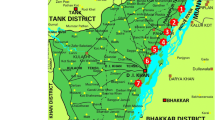Abstract
Spatio-temporal variations of biochemical oxygen demand (BOD) and total coliform (TC) in the Han River, Korea, were investigated in terms of concentration-based and mass loading-based approaches. Considering the river water quality criteria regulated by the Ministry of Environment in Korea, the tributaries linked to the mainstream of the Han River were found to be highly contaminated with respect to both BOD and TC and, in fact, most of the tributaries exceeded the maximum water quality criteria. To evaluate the pollution impact of tributaries on the mainstream, the monthly water quality monitoring data for six years (from 1995 to 2000) were collected from the Han River basin, and statistically analyzed using Pearson’s correlation coefficient. The results revealed that mass loading-based approach was superior to the concentration-based approach for effective Han River watershed management. Overall results supported that the mass loading-based approach associated with total maximum daily loads (TMDL) management would be a useful and suitable protocol in watershed management for improving the water quality of the Han River and protecting public health. Therefore, this study supporting TMDL management can be applicable to a wide array of contaminants and watershed settings in Korea.





Similar content being viewed by others
References
APHA (American Public Health Association) (1995) Standard Methods for the Examination of Water and Wastewater (18th eds). APHA, Washington, DC
Byappanahalli MN, Fujioka RS (1998) Evidence that tropical soil environment can support the growth of Escherichia Coli. Water Science and Technology 38:171–174
Crowther J, Kay D, Wyer MD (2001) Relationships between microbial water quality and environmental conditions in coastal recreational waters: the Fylde coast, UK. Water Research 35:4029–4038
Desmarais TR, Solo-Gabriele H, Palmer CJ (2002) Influence of soil on fecal indicator organisms in a tidally influenced subtropical environment. Applied and Environmental Microbiology 68:1165–1172
Fujioka RS (2001) Monitoring coastal marine waters for spore-forming bacteria of faecal and soil origin to determine point from non-point source pollution. Water Science and Technology 44:181–188
Fujioka RS, Unutoa TM (2006) Comparative stability and growth requirements of S. aureus and faecal indicator bacteria in seawater. Water Science and Technology 54:169–175
George T, Franklin LB (3rd eds) (1991) Wastewater Engineering: Treatment, Disposal, and Reuse. McGraw-Hill, New York
HRBEO (Han River Basin Environmental Office) (2001) A statistical yearbook of Environment in Han River Basin. HRBEO, Gyeonggi Province, Korea
Ki SJ, Lee YG, Kim SW, Lee YJ, Kim JH (2007a) Spatial and temporal analyses toward the total maximum daily loads management for the Yeongsan watershed in Korea. Water Science and Technology 55:367–374
Ki SJ, Ensari S, Kim JH (2007b) Solar and Tidal Modulations of Fecal Indicator Bacteria in Coastal Waters at Huntington Beach, California. Environmental Management 39:867–875
Kim JH, Grant SB (2004) Public mis-notification of coastal water quality: A probabilistic evaluation of posting errors at Huntington Beach, California. Environmental Science and Technology 38:2497–2504
Kim JH, Grant SB, McGee CD, Sanders BF, Largier JL (2004) Locating sources of surf zone pollution: A mass budget analysis of fecal indicator bacteria at Huntington Beach, California. Environmental Science and Technology 38:2626–2636
Lipp EK, Rodriguez-Palacios C, Rose JB (2001) Occurrence and distribution of the human pathogen Vibrio vulnificus in a subtropical Gulf of Mexico estuary. Hydrobiologia 460:165–173
Mallin MA, Williams KE, Esham EC, Lowe RP (2000) Effect of human development on bacteriological water quality in coastal watersheds. Ecological Applications 10:1047–1056
MCT (Ministry of Construction, Transportation) (1999) An annual flow rate report, 1998. MCT, Gyeonggi Province, Korea
ME (Ministry of Environment) (1998) Comprehensive countermeasures against water quality management of drinking water in Han River. ME, Gyeonggi Province, Korea
ME (Ministry of Environment) (2000) A basic statistical yearbook of Environment. ME, Gyeonggi Province, Korea
Mudelsee M (2003) Estimating Pearson’s correlation coefficient with bootstrap confidence interval from serially dependent time series. Mathematical Geology 35:651–665
Ryu MJ, Park CB, Koo JY, Cho YM, Cho HM (2002) Analysis to the affect of Wangsukchon using modified RMA model. Journal of Korean Society of Environmental Engineers 24:1405–1413
Shin JS, Jung JH, Oh KD, Ra KH (2001) Prediction of water quality in Tan stream of the Han River. Korean Journal of Environmental Health Society 27:49–56
Solo-Gabriele HM, Wolfert MA, Desmarais TR, Palmer CJ (2000) Sources of Escherichia coli in a coastal subtropical environment. Applied and Environmental Microbiology 66:230–237
Yoo HS (2004) Monthly fluctuation of the Han River water quality. Journal of Korean Society on Water Quality 20:352–356
Acknowledgments
This work was supported by Korea Ministry of Environment as “The Eco-technopia 21 project” and the basic research project (GE02690) through a grant provided by the Gwangju Institute of Science and Technology in 2007. We gratefully acknowledge the National Institute of Environmental Research (NIER) in Korea and the Korea Water Resources Corporation (KOWACO) for their support in providing monitoring data.
Author information
Authors and Affiliations
Corresponding author
Rights and permissions
About this article
Cite this article
Kim, JW., Ki, S.J., Moon, J. et al. Mass Load-Based Pollution Management of the Han River and Its Tributaries, Korea. Environmental Management 41, 12–19 (2008). https://doi.org/10.1007/s00267-007-9030-1
Published:
Issue Date:
DOI: https://doi.org/10.1007/s00267-007-9030-1




